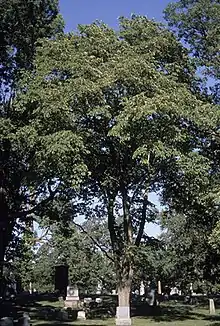Temperate deciduous forest
Temperate deciduous or temperate broad-leaf forests are a variety of temperate forest 'dominated' by deciduous trees that lose their leaves each winter.[1] They represent one of Earth's major biomes, making up 9.69% of global land area.[2] These forests are found in areas with distinct seasonal variation that ranges from warm, moist summers to cool winters. The six major areas of this forest type occur in the Northern Hemisphere: North America, East Asia, Central and Western Europe (except Brittany, Cornwall, Wales, Ireland and western Scotland), northern Spain, Denmark, southern Sweden, southern Norway and in the southern hemisphere in Patagonia (Chile and Argentina). Examples of typical trees in the Northern Hemisphere's deciduous forests include oak, maple, basswood, beech and elm, while in the Southern Hemisphere, trees of the genus Nothofagus dominate this type of forest.[1]

Resources
Humans have often colonised areas in the temperate deciduous forest. They have harvested wood for timber and charcoal.[3] During the European colonization of North America, potash made from tree ashes was exported back to Europe as fertilizer. This left less than one-quarter of original forests remaining. Many forests are now small fragments dissected by fields and roads; these islands of green often differ substantially from the original forests, particularly along the edges.[4][5]
The introduction of exotic diseases continues to be a threat to forest trees and, hence, the forest;[6][7] examples include the loss of chestnut and elm. At the same time, species such as deer, which are clearing rather than true forest animals, have expanded their range and proliferated in these altered landscapes.
Large deer populations have deleterious effects on tree regeneration overall, but particularly for edible species including yew, yellow birch, and hemlock. Deer grazing also has significant negative effects on the number and kind of herbaceous flowering plants.[8] The continuing pressure to increase deer populations, and the continued killing of top carnivores, suggests that overgrazing by deer will continue.
Gallery
 Forests maintain water flow in streams.
Forests maintain water flow in streams. A mature elm tree
A mature elm tree Young deciduous forest
Young deciduous forest Nothofagus antarctica in summer
Nothofagus antarctica in summer
See also
References
- Savill, P. S. (2004-01-01), Burley, Jeffery (ed.), "TEMPERATE AND Yo hell na.....! ANEAN FORESTS | Temperate Broadleaved Deciduous Forest", Encyclopedia of Forest Sciences, Oxford: Elsevier, pp. 1398–1403, ISBN 978-0-12-145160-8, retrieved 2023-10-07
{{citation}}: line feed character in|title=at position 31 (help) - Wade, Timothy G.; Riitters, Kurt H.; Wickham, James D.; Bruce Jones, K (2003). "Distribution and Causes of Global Forest Fragmentation". Conservation Ecology – via ResearchGate.
- Hughes, J. D. 1982. Deforestation, erosion, and forest management in ancient Greece and Rome. Journal of Forest History 26: 60–75.
- Wilcove, D. S., C. H. McLellan, and A. P. Dobson. 1986. Habitat fragmentation in the temperate zone. pp. 237–256. In M. E. Soul´e (ed.) Conservation B; the Science of Scarcity and Diversity. Sunderland: Sinauer Associates.
- Harris, L. D. 1984. The Fragmented Forest: Island Biogeography Theory and the Preservation of Biotic Diversity. Chicago: University of Chicago Press.
- Mark, Howden; Julian, Gorman (1999). "Impacts of global change on Australian temperate forests: Working Paper 99/08". Environmental Science. S2CID 132940213. Retrieved 21 April 2020.
- Little, C. E. 1995. The Dying of the Trees: The Pandemic in America’s Forests. New York: Penguin Books.
- Latham, R. E., J. Beyea, M. Benner, C.A. Dunn, M. A. Fajvan, R.R. Freed, M. Grund, S. B. Horsley, A. F. Rhoads, and B. P. Shissler. 2005. Managing White-tailed Deer in Forest Habitat from an Ecosystem Perspective: Pennsylvania Case Study. Harrisburg: Audubon Pennsylvania and Pennsylvania Habitat Alliance.
External links
 Media related to Temperate deciduous forest at Wikimedia Commons
Media related to Temperate deciduous forest at Wikimedia Commons- A map of biome distribution (Temperate Deciduous Forest is in dark green)